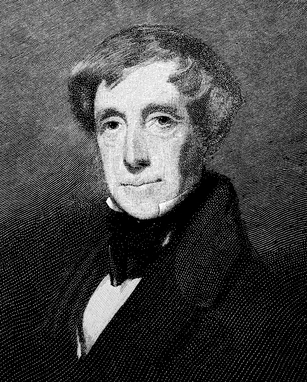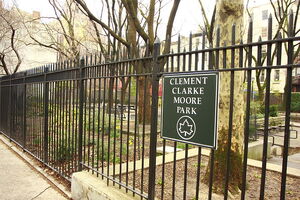
Clement Clark Moore (1779-1863) from The Century (Dec. 1897). Courtesy Wikimedia Commons.
| Clement Clarke Moore | |
|---|---|
| Born |
July 15, 1779 New York City |
| Died |
July 10, 1863 (aged 83) Newport, Rhode Island |
Clement Clarke Moore (July 15, 1779 - July 10, 1863) was an American poet and academic. He is commonly considered to be the author of the yuletide poem "A Visit from St. Nicholas," better known as "The Night Before Christmas."
Life[]
Overview[]
Moore was a professor of Oriental and Greek literature at Columbia College, now Columbia University. He donated land from his family estate for the foundation of the General Theological Seminary, where he was a professor of Biblical learning, and compiled a two volume Hebrew dictionary.
Youth and education[]
Moore was born on July 15, 1779, to Charity (Clarke) and Benjamin Moore, and grew up in the family residence in Elmhurst, Queens.[1]
He was a graduate of Columbia College (1798), where he earned both a B.A. and an M.A..
Career[]
In 1820, Moore helped Trinity Church organize a new parish church, St. Lukes in the Fields, on Hudson Street,[2] and the following year he was made professor of Biblical learning at the General Theological Seminary in New York, a post that he held until 1850. The ground on which the seminary now stands was his gift.[3]
From 1840 to 1850, he was a board member of the New York Institution for the Blind at 34th Street and Ninth Avenue, which is now the New York Institute for Special Education. He compiled a Hebrew and English Lexicon (1809), and published a collection of poems (1844). Upon his death in 1863 at his summer residence in Newport, Rhode Island, his funeral was held in Trinity Church, Newport, where he had owned a pew. Then his body was interred in the cemetery at St. Luke in the Fields. On November 29, 1899, his body was reinterred in Trinity Churchyard Cemetery in New York.
Moore opposed the abolition of slavery, and owned several slaves during his lifetime.[4]
Chelsea[]
A rendering of the Mansion House of the Chelsea estate by Moore's daughter, Mary C. Ogden. made for the first color edition of A Visit from St. Nicholas (1855)
Moore's estate, Chelsea, was on the west side of Manhattan island above Houston Street, where the developed city ended at the time, and was mostly open countryside.[2] It was once the property of Maj. Thomas Clarke, Clement's maternal grandfather and a retired British veteran of the French and Indian War. Clarke named his house for a hospital in London that served war veterans. The estate was later inherited by Thomas Clarke's daughter, Charity Clarke Moore, and ultimately by grandson Clement and his family.
When New York City laid down the street grid called for in the Commissioner's Plan of 1811, the new Ninth Avenue went through the middle of the estate, causing Moore to write and publish a pamphlet which called on other "Proprietors of Real Estate" to fight the continued development of the city, which he saw as a conspiracy designed to increase political patronage and appease the city's working class. He also decried having to pay taxes for public works such as creating new streets, which he called "a tyranny no monarch in Europe would dare to exercise."[2]
Despite his protests against urban development, eventually Moore began to develop Chelsea, dividing it up into lots along Ninth Avenue and selling them to well-heeled New Yorkers. He also donated to the Episcopal diocese an apple orchard consisting of 66 tracts for use as a seminary, construction on which began in 1827. This became the General Theological Seminary, where Moore served as the 1st professor of Oriental languages, and which still survives on the same site, taking up most of the block between 20th and 21st Streets and Ninth and Tenth Avenues. 10 years later, Moore also gave land on Ninth and 20th Street, east of the avenue, for St. Peter's Episcopal Church.[2]
Townhouses in Chelsea; much of this Manhattan neighborhood was originally part of Moore's country estate
Today, the Manhattan neighborhood which emerged from Moore's ancestral estate is still called Chelsea.
Family[]
As a girl, Moore's mother, Charity Clarke, wrote letters to her English cousins that are preserved at Columbia University and show her disdain for the policies of the English Monarchy and her growing sense of patriotism in pre-revolutionary days.
Clement Clarke Moore's wife, Catharine Elizabeth Taylor, was of English and Dutch descent, being a direct descendant of the Van Cortlandt family, once the major landholders in the lower Hudson Valley of New York.
The Moore children have several living descendants including members of the Ogden family. In 1855, one of Clement's daughters, Mary C. Moore Ogden, painted "illuminations" to go with her father's celebrated verse.
"The Night Before Christmas"[]
- Main article: A Visit from St. Nicholas
The poem titled "Account of a Visit from St. Nicholas," "arguably the best-known verses ever written by an American",[5] was originally published anonymously in the Troy, New York, Sentinel on December 23, 1823, and was reprinted frequently thereafter with no name attached. Moore later acknowledged authorship and the poem was included in an 1844 anthology of his works[6] at the insistence of his children, for whom he wrote it.
A Visit from St. Nicholas is largely responsible for the conception of Santa Claus from the mid-19th century to today, including his physical appearance, the night of his visit, his mode of transportation, the number and names of his reindeer, and the tradition that he brings toys to children. Prior to the poem, American ideas about St. Nicholas and other Christmastide visitors varied considerably. The poem has influenced ideas about St. Nicholas and Santa Claus beyond the United States to the rest of the English-speaking world and beyond.
Moore's connection with the poem has been questioned by Professor Donald Foster, an expert on textual content analysis, who used external and internal evidence to argue that Moore could not have been the author.[7] Major Henry Livingston, Jr., a New Yorker with Dutch and Scottish roots, is considered the chief candidate for authorship, if Moore did not write it. Livingston was distantly related to Moore's wife.[7]
Recognition[]
Clement Clarke Moore Park[]

Clement Clarke Moore Park. Photo by Tony, Wikipedia Takes Manhattan, 2008. Licensed under Creative Commons, courtesy Wikipedia Commons.
Clement Clarke Moore Park, located at 10th Avenue and 22nd Street, is named after Moore. The playground there opened November 22, 1968, and it was named in memory of Moore by local law the following year. 1995 renovations to Clement Clarke Moore Park included a new perimeter fence, modular play equipment, safety surfacing, pavements and transplanted trees. This park is a well-liked and in-demand playground area used daily by local residents, who also gather there on the last Sunday of Advent for a reading of Twas the Night Before Christmas.[8]
Publications[]
Poetry[]
- Poems. New York: Barlett & Welford, 1844.
Non-fiction[]
- Observations upon certain passages in Mr. Jefferson's notes on Virginia, which appear to have a tendency to subvert religion, and establish a false philosophy. New York: 1804.
Juvenile[]
- The Night before Christmas (illustrated). Chicago: M.A. Donohue, 1910.
- The Night before Christmas (illustrated by Everett Shin). Chicago: John C. Winston, 1942.
- The Night before Christmas (illustrated by Barbara Reid). Publisher: Chicago: Albert Whitman, 2014.
Except where noted, bibliographical information courtesy WorldCat.[9]
See also[]

Old Santeclaus By Clement Clark Moore
References[]
- Burrows, Edwin G. & Mike Wallace (1999). Gotham: A history of New York City to 1898. New York: Oxford University Press. ISBN 0-19-511634-9
- Foster, Donald (2000). Author Unknown: On the Trail of Anonymous. New York: Henry Holt. ISBN 0-8050-6357-9.
- James W. Moore (1903), Rev. John Moore of Newtown, Long Island and some of his Descendants. Easton, PA:Chemical Publishing Company, p.107.
- Nissenbaum, Stephen (1997). The Battle for Christmas: A Social and Cultural History of Christmas that Shows How It Was Transformed from an Unruly Carnival Season into the Quintessential American Family Holiday. New York: Alfred A. Knopf. ISBN 0-679-41223-9.
- This article incorporates text from an edition of the New International Encyclopedia that is in the public domain.. Original article is at:
- Stedman, Edmund Clarence, An American Anthology (Boston, 1900)
- Observations upon Certain Passages in Mr. [Thomas] Jefferson's Notes on Virginia which Appear to have a Tendency to Subvert Religion, and Establish A False Philosophy (New York, 1804).
- "The Night Before Christmas", New York Sentinel on December 23. The original publisher hinted at Moore’s authorship in 1829. Moore was first credited as author by Charles Fenno Hoffman, ed., The New-York Book of Poetry (New York: George Dearborn, 1837)
- Nickell, Joe. "The Case of the Christmas Poem." Manuscripts, Fall 2002, 54;4:293-308, and Manuscripts, Winter 2003, 55;1:5-15
- Nissenbaum, Stephen. The Battle for Christmas: A Cultural History of America’s Most Cherished Holiday (New York: Vintage, 1996)
- Kaller, Seth T. “The Moore Things Change…,” The New-York Journal of American History, Fall 2004
Notes[]
- ↑ A Woman Ready to Fight, New York Newsday, by George DeWan
- ↑ 2.0 2.1 2.2 2.3 Burrows & Wallace p.447
- ↑ New International Encyclopedia
- ↑ Samuel W. Patterson, The Poet of Christmas Eve: A Life of Clement Clarke Moore, 1779-1863, (New York: Morehouse-Gorman Co, 1956)
- ↑ Burrows & Wallace, pp.462-463
- ↑ Siefker, Phyllis (1997). Santa Claus,. McFarland & Company. pp. 4. ISBN 0786402466.
- ↑ 7.0 7.1 "Major Henry Livingston, Jr. (1748–1828) Account of a Visit from St. Nicholas", Representative Poetry Online
- ↑ New York City Department of Parks & Recreation: Clement Clarke Moore Park
- ↑ Search results = au:Clement Clarke Moore, WorldCat, OCLC Online Computer Library Center Inc. Web, Aug. 21, 2018.
External links[]
- Poems
- Selected Poetry of Clement Clarke Moore (1779-1863) at Representative Poetry Online,
- A Visit from Saint Nicholas by Clement Clark Moore at the Academy of American Poets.
- Clement Clark Moore at the Poetry Foundation
- Clement Clark Moore at PoemHunter (3 poems)
- Audio
- Free audiobook of Twas the Night Before Christmas from LibriVox
- Clement Clark Moore at YouTube
- Books
- Works by Clement Clarke Moore at Project Gutenberg
- Clement Clarke Moore at Amazon.com
- About
- Clement Clark Moore at NNDB.
- Peter Christoph, "Clement Moore revisited", 1982
- The Night Before Christmas Bibliography by Nancy H. Marshall
- Urban Legends - Clement Clarke Moore: The Reluctant Mythmaker
- "Literary Sleuth Casts Doubt on the Authorship of an Iconic Christmas Poem", New York Times
- Clement Clark Moore at Find a Grave
| This page uses Creative Commons Licensed content from Wikipedia. (view article). (view authors). |
| This page uses content from Wikinfo . The original article was at Wikinfo:Clement Clarke Moore. The list of authors can be seen in the (view authors). page history. The text of this Wikinfo article is available under the GNU Free Documentation License and the Creative Commons Attribution-Share Alike 3.0 license. |
|